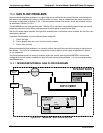
Troubleshooting & Repair Teledyne API – Technical Manual - Model 300E Family CO Analyzers
282
13.2.2. TYPICAL SAMPLE GAS FLOW PROBLEMS
13.2.2.1. Flow is Zero
The unit displays a SAMPLE FLOW warning message on the front panel display or the SAMPLE FLOW test
function reports a zero or very low flow rate.
Confirm that the sample pump is operating (turning). If not, use an AC voltmeter to make sure that power is
being supplied to the pump if no power is present at the electrical leads of the pump.
1. If AC power is being supplied to the pump, but it is not turning, replace the pump.
2. If the pump is operating but the unit reports no gas flow, perform a flow check as described in Section
12.3.4.
3.
If no indepen
dent flow meter is available:
Disconnect the gas lines from both the sample inlet and the exhaust outlet on the rear panel of the
instrument.
Make sure that the unit is in basic SAMPLE Mode.
Place a finger over an Exhaust outlet on the rear panel of the instrument.
If gas is flowing through the analyzer, you will feel pulses of air being expelled from the Exhaust
outlet.
4. If gas flows through the instrument when it is disconnected from its sources of zero air, span gas or
sample gas, the flow problem is most likely not internal to the analyzer. Check to make sure that:
All calibrators/generators are turned on and working correctly.
Gas bottles are not empty or low.
Valves, regulators and gas lines are not clogged or dirty.
13.2.2.2. Low Flow
1. Check if the pump diaphragm is in good condition. If not, rebuild the pump (see Section 12.3.2). Check
the Spare Parts List for information on pump rebuild kits.
2. Check for leaks as described in Section 12.3.3. Repair the leaking fitting, line or valve and re-check.
3. Che
ck for the sample filter and the orifice filter for dirt. Replace filters (see 12.3.1).
4. Che
ck for partially plugged pneumatic lines, or valves. Clean or replace them.
5. Check for plugged or dirty critical flow orifices. Replace them.
6. If an IZS option is installed in the instrument, press CALZ and CALS. If the flow increases then suspect
a bad sample/cal valve.
13.2.2.3. High Flow
The most common cause of high flow is a leak in the sample flow control assembly or between there and the
pump. If no leaks or loose connections are found in the fittings or the gas line between the orifice and the pump,
replace the critical flow orifice(s) inside the sample flow control assembly.
04288D DCN5752


















